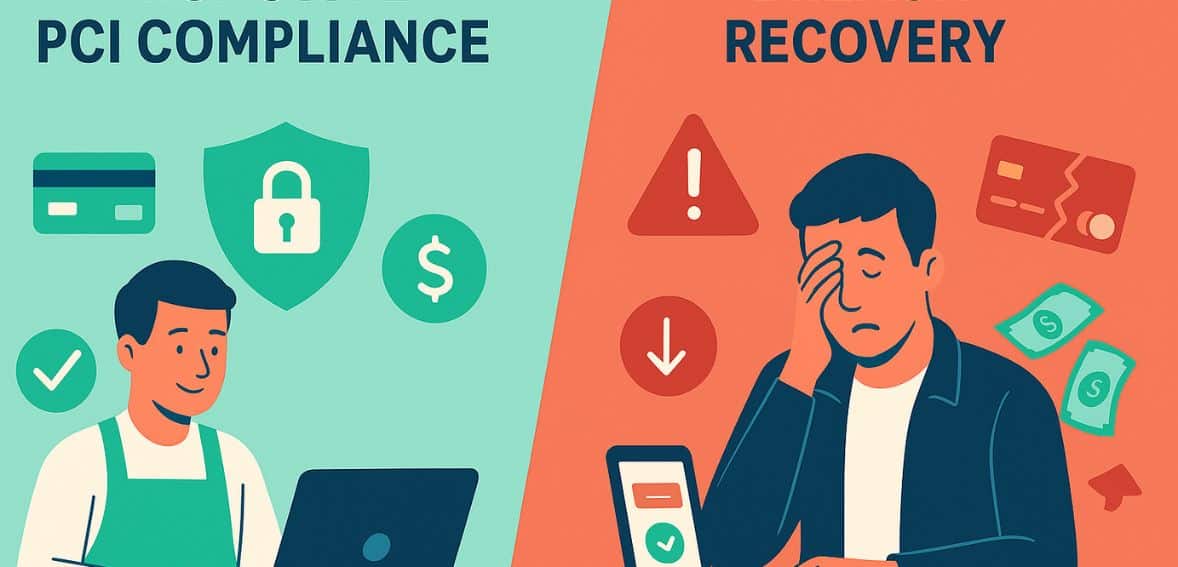
By alphacardprocess September 17, 2025
Data security is a basic requirement in today’s digital economy, where companies handle card payments daily. Every transaction has inherent risks, but also symbolizes a point of trust between the buyer and the seller. To make sure that companies adhere to procedures intended to protect sensitive data, the Payment Card Industry Data Security Standard (PCI DSS) was developed.
Many organizations, however, continue to undervalue the financial and reputational consequences of a data breach by weighing the costs of proactive PCI compliance against the perceived likelihood of one. Businesses must carefully weigh the long-term advantages of compliance against the startling costs of breach recovery in order to fully understand the trade-offs.
Why PCI Compliance Matters

PCI compliance is a framework for trust as well as a collection of the industry’s rules. Customers believe that their information won’t be misused when they swipe, dip, or tap their card.
Compliance guarantees that payment systems have access controls, monitoring, and encryption to reduce the exposure of sensitive data. Beyond preserving customer confidence, PCI standards shield companies from fines, chargeback disputes, and expensive investigations.
Businesses that put a high priority on compliance convey accountability and professionalism, which improves their standing with clients and payment processors. Without this dedication, businesses expose themselves to regulatory penalties, strained ties with banks and card networks, and hackers.
Strengthening Vendor and Partner Relationships
The function of PCI compliance in vendor and partner relationships is another aspect that is often overlooked. Businesses without compliance certifications will be rejected by a number of card networks, payment processors, and even major retail customers.
As a result, PCI serves as both a legal necessity and a means of establishing more solid cooperation and expanding business prospects. Businesses in highly competitive industries may be able to obtain better contracts and more advantageous processing rates if they can prove verified compliance.
It is evident that not investing in standards restricts opportunities before a breach even occurs, when comparing the costs of compliance with breach recovery. In addition to being defensive, compliance is a strategic tool that aids in business growth and draws in security-conscious partners.
The Direct Costs of PCI Compliance
There are actual costs associated with implementing PCI compliance. This could involve investing in secure network infrastructure, implementing tokenization or encryption tools, and updating payment terminals for small businesses.
Larger businesses must pay more for third-party evaluations, audits, and staff training. The annual cost of compliance can vary from hundreds to hundreds of thousands of dollars, depending on the size and volume of transactions. These expenses might seem onerous at first, particularly for businesses with limited funds.
However, in contrast to the unmanaged financial chaos that ensues after a data breach, these expenses are predictable, planned, and comparatively low. Because of this predictability, compliance is not an existential threat but rather a manageable line item.
Compliance as a Merchant’s Shield

The idea that PCI compliance costs only benefit cardholders or payment brands is among the most widespread misconceptions. The merchant is actually the first to be protected by compliance. It lowers the likelihood of fines, shields the merchant from legal responsibility, and keeps them from having to pay for fraud that is committed by criminals taking advantage of weaknesses.
Additionally, because compliant companies have a lower risk profile, compliance enables merchants to bargain with processors for better terms. In certain instances, clients who continuously maintain compliance may even receive fee reductions or improved support services from processors.
These advantages add actual financial value even though they are not shown as line items on a statement. There is no such benefit to breach recovery; instead, there are expenses, fines, and a difficult time winning back the trust of customers.
Hidden Benefits of Proactive Compliance
PCI compliance has hidden benefits that are often overlooked, in addition to the evident decrease in breach risk. For example, by requiring companies to reduce redundancies and document processes, compliance streamlines operational efficiency.
Because many partners prefer to work with merchants who exhibit high security standards, it enhances vendor relationships. Customers are more likely to return to companies they believe to be reliable, and insurance companies may give compliant organizations lower rates.
Compliance serves as a competitive advantage in a market where customers are becoming more conscious of cybersecurity threats, differentiating safe retailers from less vigilant competitors. Despite being more difficult to measure, these intangible benefits have a significant impact on long-term profitability.
Compliance as a Catalyst for Modernization
When taken as a whole, PCI compliance frequently serves as a driving force behind a company’s larger digital transformation. Companies frequently update their outdated IT infrastructure in response to the need to segment networks, encrypt data, and track access.
In addition to enhancing security, this modernization increases operational performance and efficiency. Employees can concentrate more on customer service and less on troubleshooting when they use more dependable, integrated systems.
As a result, compliance serves as a starting point for more significant operational enhancements that have an impact on the entire company. This stands in stark contrast to breach recovery, which necessitates hurried expenditures on patchwork fixes during emergencies. Instead of responding to crises, proactive investments in compliance enable companies to determine their own growth rate.
The Catastrophic Costs of Breach Recovery

Businesses risk catastrophic consequences when they decide to ignore or disregard PCI compliance. A data breach damages a brand’s reputation, credibility, and trust in addition to costing money.
The average financial cost of a breach, including forensic investigations, card replacement fees, customer notifications, and regulatory fines, frequently exceeds hundreds of thousands of dollars. Legal advice, settlements, and possible litigation from impacted clients or partners are also necessary for recovery.
The reputational damage, however, is more detrimental than the actual expenses. After a single breach, many customers will completely stop doing business with a company because they are much less forgiving once their private information has been compromised.
Regulatory and Legal Ramifications
A breach can have disastrous legal consequences in addition to the financial cost. Merchants who violate PCI standards face severe penalties from regulators, even if a sophisticated cyberattack was the cause of the breach. Following an incident, state and federal laws frequently require certain actions, like giving victims credit monitoring services, which comes at a hefty cost.
Additionally, non-compliance may make it impossible for a business to continue accepting card payments at all, thereby cutting off its vitality. Compliance could have avoided the worst-case scenario for many merchants, which is losing their merchant account or payment processor relationship.
Time as an Overlooked Cost
One of the most underestimated expenses that businesses encounter is the time lost during breach recovery. Systems are taken offline, and employees are relieved of their regular duties while forensic teams conduct their investigation.
As attention turns from customer service to damage control, operations come to a complete stop. This lost productivity, which frequently occurs during crucial times when companies can least afford downtime, directly translates into lost revenue.
The time spent on proactive compliance, on the other hand, is planned and managed to cause the least amount of disruption to operations. It is easier to understand why prevention is always less expensive than treatment when compliance is framed as a time-management strategy rather than merely a financial choice.
Protecting Leadership Time
The way that obstacles restrict leadership focus is another aspect of time management. Instead of promoting growth and innovation, executives and managers are enmeshed in forensic meetings, public relations campaigns, and legal negotiations.
This leadership diversion has a huge opportunity cost, particularly in sectors where survival depends on creativity and agility. By allowing leaders to concentrate on customers and strategic development instead of crisis management, proactive compliance reduces this drain.
It reframes security as a means of protecting leadership time, which is the most valuable and scarce resource in any business, rather than as a reactive measure. Time is spent creating the future rather than fixing the past when a compliance-first strategy is used.
Customer Retention and Brand Value

A business’s brand is built over years of consistent service, but can be destroyed in days by a single security incident. Customers who experience fraud linked to a business’s systems often feel personally betrayed, leading them to cut ties and spread negative reviews. In an era of social media amplification, bad news travels quickly and lingers indefinitely online.
Conversely, when a business openly communicates its commitment to security and demonstrates PCI compliance, it nurtures loyalty and confidence. Customers are more likely to spend with businesses they trust, meaning compliance directly supports customer retention and lifetime value. This brand equity is priceless compared to the devastation of lost trust.
Turning Compliance into a Marketing Advantage
As consumers become more tech-savvy, brand trust is becoming more closely linked to security. Customers prefer to do business with businesses that make it clear that they are committed to protecting sensitive information, according to numerous surveys.
Marketing campaigns can be actively enhanced by showcasing PCI compliance seals or highlighting security initiatives, transforming a legal requirement into a differentiator for your brand. On the other hand, rebranding initiatives, expensive advertising campaigns, and incentive schemes to entice back customers are frequently part of the recovery process following a breach.
These attempts may be far more expensive than proactive compliance initiatives and rarely result in a complete restoration of trust. Businesses present themselves as progressive and customer-focused in a market where loyalty is fueled by trust when they approach PCI compliance as a component of brand building rather than merely technical infrastructure.
Small Businesses vs. Large Enterprises
The cost-benefit analysis of compliance varies somewhat by business size. Large enterprises face higher compliance costs due to their complexity, but also have more resources to absorb them.
For small businesses, the upfront expense can feel more acute, but the impact of a breach is also more devastating. A single data breach has the potential to bankrupt a small merchant, wiping out years of hard work in a matter of weeks.
For this reason, small businesses arguably have even more to gain from PCI compliance, despite limited budgets. In both cases, the proportional cost of compliance pales in comparison to the damage of breach recovery.
Building a Culture of Compliance
PCI compliance works best when it is viewed as a continuous security culture rather than a one-time endeavor. Protecting customer data becomes second nature when employees are trained, systems are monitored, and audits are conducted regularly.
One of the main reasons for breaches is human error, which is less likely to occur with this cultural approach. Businesses build resilience that surpasses regulatory requirements by integrating compliance into day-to-day operations.
Long-term, this kind of culture not only reduces the likelihood of breaches but also gets organizations ready for standards that change over time, allowing them to adjust to future advancements in payment security. Businesses hoping to safeguard sensitive customer data should conduct regular risk assessments in payment security. Doing so helps identify hidden threats, prioritize remediation efforts, and reduce the odds of costly data breaches.
Long-Term Financial Stability

Businesses that make PCI compliance commitments frequently have more stable financial standing. They safeguard their bottom line by avoiding expensive violations, fines from the authorities, and interruptions in business operations.
Instead of being unpredictable emergencies that risk life, compliance costs become a predictable component of annual budgeting. Additionally, since lenders tend to see compliant businesses as lower risk, they are better positioned to obtain financing.
Consistently investing in compliance eventually results in a stronger, more stable financial position. One of the strongest arguments for decision-makers to put compliance ahead of the unpredictability of breach recovery is this stability.
Conclusion
The costs of breach recovery and PCI compliance are not closely related. Although it necessitates planning, funding, and ongoing effort, compliance is a manageable and advantageous expense that fortifies a company’s base.
In contrast, the recovery process of a breach is chaotic, unpredictable, and devastating. Companies that put a high priority on proactive compliance not only protect themselves from financial ruin but also improve their operational efficiency, customer loyalty, and reputation.
PCI compliance is about safeguarding the future, not just avoiding fines, in a market where trust is currency. The true cost lies not in compliance but in not appreciating its worth until it is too late.